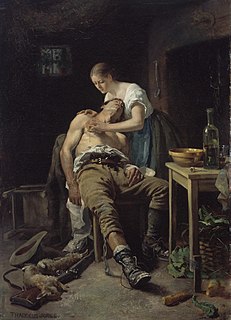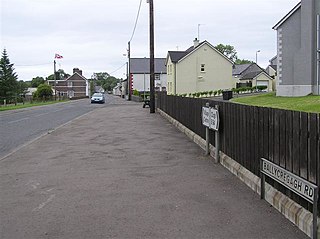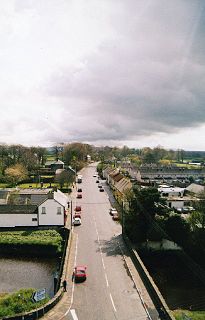
The Irish National Land League was an Irish political organisation of the late 19th century which sought to help poor tenant farmers. Its primary aim was to abolish landlordism in Ireland and enable tenant farmers to own the land they worked on. The period of the Land League's agitation is known as the Land War. Historian R. F. Foster argues that in the countryside the Land League "reinforced the politicization of rural Catholic nationalist Ireland, partly by defining that identity against urbanization, landlordism, Englishness and—implicitly—Protestantism." Foster adds that about a third of the activists were Catholic priests, and Archbishop Thomas Croke was one of its most influential champions.

Ballymoney was a local government district with borough status in Northern Ireland. It was headquartered in Ballymoney. Other towns in the borough included Dervock, Dunloy, Cloughmills and Rasharkin. The borough had a population of 31,224 according to the 2011 census.

The Plantation of Ulster was the organised colonisation (plantation) of Ulster – a province of Ireland – by people from Great Britain during the reign of King James VI & I. Most of the colonists came from Scotland, the majority having a different culture to the natives. Small private plantations by wealthy landowners began in 1606, while the official plantation began in 1609. Most of the land colonised was forfeited from the native Gaelic chiefs, several of whom had fled Ireland for mainland Europe in 1607 following the Nine Years' War against English rule. The official plantation comprised an estimated half a million acres (2,000 km²) of arable land in counties Armagh, Cavan, Fermanagh, Tyrone, Tyrconnell and Derry/Londonderry. Land in counties Antrim, Down and Monaghan was privately colonised with the king's support.

North Antrim is a parliamentary constituency in the United Kingdom House of Commons. Its current member is Ian Paisley Jr.

Rasharkin, is a small village, townland and civil parish in County Antrim, Northern Ireland. It is 13 kilometres (8.1 mi) south of Ballymoney, near Dunloy and Kilrea. It had a population of 1,114 people in the 2011 Census.

Cloughmills or Cloghmills is a village in County Antrim, Northern Ireland. Ballymoney is 15 km to the north-west and Ballymena is 16 km to the south. It had a population of 1,309 people in the 2011 Census. It is in Causeway Coast and Glens District Council.

Dervock is a small village and townland in County Antrim, Northern Ireland. It is about 3.5 miles (6 km) northeast of Ballymoney, on the banks of the Dervock River. It is situated in the civil parish of Derrykeighan and the historic barony of Dunluce Lower. It had a population of 714 people in the 2011 Census.

The Irish Land and Labour Association (ILLA) was a progressive movement founded in the early 1890s in Munster, Ireland, to organise and pursue political agitation for small tenant farmers' and rural labourers' rights. Its branches also spread into Connacht. The ILLA was known under different names—Land and Labour Association (LLA) or League (LLL). Its branches were active for almost thirty years, and had considerable success in propagating labour ideals before their traditions became the basis for the new labour and trade unions movements, with which they gradually amalgamated.
The Northern Irish Troubles resulted in 14 deaths in or near the County Antrim town of Ballymoney; the sole incident involving two or more fatalities was the Quinn brothers' killings in July 1998. The three Catholic brothers, aged 9, 10 and 11, were killed during a sectarian Ulster Volunteer Force petrol bomb attack on their home at Carnany Park, in a predominantly Protestant area of Ballymoney. The family had only moved into the house the previous week. The mother and her partner escaped, but couldn't save the three children.

The A26 is a road in Northern Ireland. It travels in a North-South direction from Coleraine, County Londonderry to Banbridge, County Down.
Maine Soft Drinks Ltd. is a company based in Ballymoney, County Antrim, Northern Ireland, which sells soft drinks, cordials and aerated waters. During the early 21st-century recession, it remained in Ballymoney while several other companies with large numbers of employees disappeared. The company was founded by John Harkness in 1949, and is named after the River Maine.
The Ballymoney Times is a regional newspaper published for the north-east area of Northern Ireland, which included the town of Ballymoney, County Antrim.
Armoy was a station which served Armoy in County Antrim, Northern Ireland. It was located on the Ballycastle Railway, a narrow gauge railway line which ran from Ballycastle to Ballymoney, entirely in County Antrim, Northern Ireland. The track gauge was 3 ft.
Samuel Butcher PC was an Irish Anglican bishop in the Church of Ireland in the 19th century.
James Brown Armour (1841–1928), usually known as J. B. Armour, was an Irish Protestant Minister and political activist.










